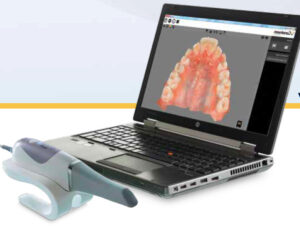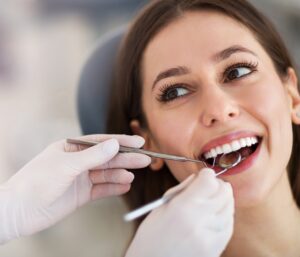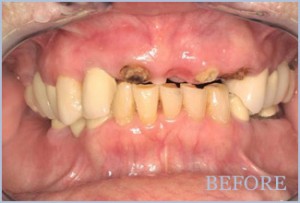Header logo
header top contact widget
Periodontitis
Optimize Your Dental Implant Experience, Results.
Posted on Jan 24, 2022 by William J. Claiborne, DDS MS
I recently had to return a small appliance at a “big box” store. I didn’t have the receipt but hoped I could at least get a store credit. When I explained this to the customer service rep, she said a receipt wasn’t necessary. She scanned the bar code and asked me if I wanted the refunded amount applied to the credit card I used to purchase it. No receipt needed, no credit card, and I was in and out of the line in no time.
With today’s technology, many processes that were once time-consuming and complicated are now simple and “painless.” Less time is required with better results. Technology has made this true, too, in dentistry.
As a periodontist, I specialize in the prevention, diagnosis, and treatment of all stages of periodontal (gum) disease. I also have advanced training and skills in the selection and placement of dental implants. In addition, periodontists are particularly skilled in performing cosmetic periodontal procedures.
As an Asheville periodontal specialist for over 30 years, I’ve treated a variety of needs that involve the gum tissues. These include:
– Treatment of all stages of gum disease (gingivitis, pregnancy gingivitis, periodontal disease, periodontitis)
– Reshaping gum tissues for esthetic enhancement (crown lengthening, gingivectomy for ‘gummy smiles’, repairing areas of gum recession)
– Diagnosis and placement of dental implants
– Treatment of lesions or cysts in oral tissues
To receive the extensive, additional 3 years of training after dental school to become a periodontist, (I believe) an individual must be passionate about the specialty. I certainly am, which is why I’m so committed to stay on top of the latest developments in the field.
This includes incorporating some of the most advanced technology available for the betterment of our Western North Carolina patients.
Our periodontal dental office features cutting edge technology, much of which is not available in other dental or periodontal offices in this region. These features help to diagnose with precision, treatment plan with superior accuracy and reduces the patient’s treatment time while optimizing comfort.
For our dental implant patients, these options have been significantly beneficial in maximizing results. Some specifically helpful in dental implant diagnosis and planning are:
LANAP With PerioLase MVP 7 – Laser-Assisted New Attachment Procedure is an advanced protocol that efficiently and effectively treats advanced gum disease with the added advantages of a dental laser. For patients who are preparing for dental implant placement, resolving gum disease prior to treatment is mandatory. LANAP offers a non-surgical alternative for patients with moderate to severe periodontal disease with very little discomfort and a quick recovery time.
Cone Beam Imaging – These amazing 3D “x-rays’ are ideal for diagnosing and treatment planning. The highly-detailed images provide a clear view of the upper and lower jaw. Because cone beam radiographs show sagittal, axial, and coronal planes, locating and tracking nerve canals optimizes implant placement. The images are captured in a quick, painless process and at minimal levels of radiation.
CareStream Cone Beam Computer Tomography Imaging – This enhanced tomography works with 3D imaging for exceptional detail and range.
Computerized Dental Implant Placement – This system provides the futuristic ability to position dental implants before the process actually begins. Through computerized technology, the implants are selected and “ideally positioned” on a 3D model of the patient’s jaw. From this, a template is developed for optimal treatment success, even for complex cases.
CS 3600 Intraoral Scanner – Rather than make impressions with bulky, goopy trays, this scanner quickly and comfortably captures digital impressions accurately and easily. These are used to create precision models or appliances (dental implant crowns, bridges, or full arches). The scanner can also reach hard–to–access areas in the patient’s mouth for superior results with improved patient comfort.
Sedation – Our Asheville periodontal practice is known for its environment of comfort and respectful care. We understand that over 70 percent of the adult population have some level of dental fear or anxiety. For optimal comfort and relaxation, we offer several sedation options, including oral and IV sedation.
Oral sedation is a pill that helps patients relax. It also has an amnesiac effect, leaving most with little or no memory of treatment afterward.
I.V. sedation (also known as ‘twilight sleep’) places the patient in a deeper sleep state and erases memory of the procedure. It is administered by a Medical Doctor (MD) who is a board certified Anesthesiologist.
With both sedation options, patients are closely monitored with advanced safety equipment throughout treatment.
When it comes to placement of dental implants, a periodontist has a unique understanding of the tender layers of gum tissues. Using gentle and precise skills when it comes to any treatment involving oral tissues, the patient experiences less disruption and incisions. When it comes to the gums, less is definitely more. We strive to optimize comfort levels and speed the healing process.
If you are considering dental implants, you may wish to begin with a consultation appointment. During this time, we can explain the vast difference in comfort, treatment time, and success available through our specialized skills and extensive technology.
Call 828-274-9440 to schedule. New patients are always welcome and a referral is not required.
E-Cigs & Oral Health
Posted on Dec 23, 2021 by William J. Claiborne, DDS MS
When it comes to vaping (using e-cigs) health risks to the heart and lungs are what tend to be the focus. However, vaping poses a number of other health risks, one being to your smile.
 Risks to your oral health makes perfect sense. Think about it – the damage from vaping would naturally begin at its entry point: your mouth.
Risks to your oral health makes perfect sense. Think about it – the damage from vaping would naturally begin at its entry point: your mouth.
Although e-cigarettes do not contain tobacco, they are still delivery systems for nicotine. In addition to being addictive, studies show that the inhaled nicotine through vaping can alter the genetic makeup of your cells. This, in turn, stimulates the growth of cancerous cells in the body and increases your risk of developing cancer.
This can lead to tumor growth in the following types of cancer:
• Lung cancer
• Gastrointestinal cancer
• Pancreatic cancer
• Breast cancer
While much remains to be determined about the hazards surrounding this “alternative” delivery system to nicotine, more and more studies are showing unfavorable outcomes. When it comes to oral health, studies are culminating in a mountain of evidence that links e-cigarettes with poor oral health.
A study published earlier this year (iScience) showed that 43 percent of people using e-cigarettes had gum disease and oral infections. That figure jumped to 73 percent among smokers.
Nicotine (inhaled by any means) restricts blood flow to the tissues in the mouth. These tissues are moist by nature and designed to absorb moisture. Because of nicotine’s harmful contents, blood flow is restricted and oral tissues become dryer.
Today’s e-cig user is likely unaware of what’s in the fluid being inhaled. The vaping mist can contain propylene glycol, benzene, formaldehyde and other chemicals.
When the oral tissues repeatedly endure hazardous components, resulting issues can be inflammation, cavities, bone loss of the structures that support teeth, advanced gum disease (known as periodontitis), and oral cancer.
Because vaping is still a recent agent for nicotine, studies on the long-term effects are underway. Still, even without a long history of findings, early studies show concerning results.
When it comes to your oral health, studies indicate that vaping increases the risk of gum disease by causing gum inflammation and swelling. When these issues are combined with a dry mouth and higher levels of bacteria, the likelihood for developing gum disease shoots up significantly.
The common symptoms of gum disease for vapers include:
• Persistent bad breath
• Gums that bleed when brushing teeth
• Tender or swollen gums
• Loose or shifting teeth
• Receding gums
The effects of vaping on the teeth and gums can cause:
Dry mouth – Nicotine from e-cigarettes reduces the saliva in your mouth, your mouth’s rinsing agent. Too little saliva can lead to dry mouth, accumulated plaque (and subsequent development of tartar), increased bacteria, and tooth decay.
Receding gums – Nicotine restricts blood vessels, reducing blood flow to the teeth and gums. Without adequate blood flow, the gums fail to get sufficient oxygen and nutrients. This can cause the gum tissues to decline, which can lead to gum recession. This can result in tooth sensitivity, a higher risk of cavities and even tooth loss.
Bruxism and tooth damage – Nicotine acts as a muscle stimulant, which can lead to tooth grinding (bruxism) or worsen already-existing problems. Grinding or clenching can lead to tooth damage, such as chipped, fractured or broken teeth.
Oral health is a critical element of whole-body health. Two preliminary studies (presented at the American Stroke Association’s International Stroke Conference) linked gum disease with a higher rate of strokes caused by hardening of large arteries in the brain and with severe artery blockages.
A 2018 study in the American Heart Association’s journal Hypertension found that gum disease appears to worsen high blood pressure and interferes with medications to treat hypertension.
It is a misconception to believe that e-cigarettes are healthier than traditional cigarettes, or that vaping isn’t bad for your smile. If you’re a smoker or vaper, be highly committed to having regular dental cleanings and exams as well as your twice-daily oral hygiene routine at home.
If, however, signs of gum disease are already present, have a periodontal examination as soon as possible. Once underway, gum disease will only worsen without treatment. Call 828-274-9440 to schedule or to learn more. As an Asheville periodontist, I have advanced skills in treating all stages of periodontal (gum) disease and in the placement of dental implants.
Our Western NC periodontal dental office also places an emphasis on advanced technology and in comfort options, including oral and IV sedation (twilight sleep).
https://www.heart.org/en/news/2020/08/26/need-another-reason-not-to-vape-your-oral-health-is-at-risk
https://www.deltadentalwa.com/blog/entry/2018/06/ecigarettes-vaping-dental-health
Cut Dental Costs With Simple Steps
Posted on Dec 15, 2021 by William J. Claiborne, DDS MS
In order to avoid costly repairs on our vehicles, we rotate our tires, have the oil changed periodically, and make sure certain fluids are at sufficient levels. This is why our annual inspections are so important; risks can be pointed out to keep us safely on the road.
The same is true with our family’s health. We stay proactive by eating healthy, staying active and having regular check-ups along with periodic screenings.
It simply makes sense to be committed to preventing problems or catch any that do arise at early stages. Research has shown that your oral health deserves the same commitment you give to maintaining a healthy body.
Studies have found a correlation between the bacteria of periodontal (gum) disease and serious problems elsewhere in the body. These include heart disease, stroke, diabetes, arthritis, preterm babies, impotency and more.
Another reason to maintain a healthy smile is to save money. By devoting about 5 minutes per day to your oral hygiene routine, coupled with having dental exams and cleanings every six months, you can prevent many problems from occurring in the first place. The reward is a savings in time and expense that may be needed for repairs – repairs that may have been prevented from occurring in the first place.
Your twice-a-year dental check-ups are opportunities to remove tartar. Tartar is a cement-hard mass of oral bacteria that forms when plaque (the sticky film that coats teeth and gums) is not removed thoroughly attaches to teeth and can no longer be brushed or flossed away.
Both plaque and the hardened mass of tartar are the result of accumulated bacteria. Oral bacteria continually reproduce in the mouth, which provides a warm, dark and moist environment. As they thrive and reproduce, they attack gum tissues.
As they amass to levels beyond what the immune system, oral bacteria can lead to gingivitis (an early stage of gum disease). Unresolved, gingivitis can develop into periodontal disease, an infection. Eventually, periodontitis develops, which is an advanced level of gum disease. At this level, teeth often loosen and must be removed.
While gingivitis causes tender gums to bleed when brushing, periodontal disease symptoms are more severe, including persistent bad breath, sore gums that bleed easily, gums that darken in color, receded gums, and pus pockets that form between teeth.
As devastating as adult tooth loss can be, the potent bacteria of gum disease can enter the bloodstream through tears in disease gum tissues. Research has shown the infectious bacteria of gum disease can activate or worsen the development of certain pathogens.
Obviously, oral bacteria is highly potent. However, it’s easy to control with twice daily brushing and daily flossing combined with regular dental checkups. For added protection, limit sugary snacks and either swish after eating or chew sugarless gum when brushing is inconvenient. Not only will you help to reduce your risk for cavities and gum problems, you’ll be able to enjoy fresher breath and smiling confidence.
It is also important to respond early to signs and symptoms of gum disease. As mentioned above, things like frequent bad breath or seeing blood in the sink when brushing are warning signs that something is wrong.
A periodontist is a dentist who has specialized skills in the diagnosis and treatment of all levels of periodontal disease. He or she can also recontour the shape of gums and place dental implants for optimal results.
If you have not seen a dentist on a regular basis, you may be experiencing symptoms that indicate gum disease. As you would respond to a warning sign with your overall health, so should you with your oral health.
Begin with a thorough examination to determine what your needs are and the best way to achieve and maintain good oral health. You’ll be supporting your overall health in addition to having a confident smile.
If dental fear has prevented you from having regular dental care, ask about sedation options. We offer both oral sedation and IV sedation (twilight sleep). Both are safely administered and you are closely monitoring throughout treatment.
You may wish to begin with a consultation. To schedule, call 828-274-9440.
Dental Fear Can Lead To Gum Disease, Tooth Loss
Posted on Nov 23, 2021 by William J. Claiborne, DDS MS
Fear is a natural reaction to things that may harm us; it’s a safety mechanism activated by the brain. Take snakes, for instance. Even harmless snakes tend to provoke an initial reaction that warns of impending danger.
Some fears are learned, however. Some people are afraid of dogs, usually stemming from a frightful encounter as children. The incident triggers something in the brain that reminds the individual, even into adulthood, that dogs are to be feared.
When it comes to the fear of dentistry, it often exists because of a traumatic incident in the patient’s past. Or, in some cases, it exists for unknown reasons. Too, certain smells, sounds or sights can trigger the “panicky” reaction some people have to dental visits.
As a periodontist in Asheville, I have a firsthand view of just what dental fear can do to oral health. Avoiding regular dental care is a sure recipe for cavities, periodontal (gum) disease, and eventual tooth loss.
Typically, adults who avoid dental visits feel they are doing an adequate job maintaining their oral wellness at home. In some minds, “I brush twice a day,” can be the justification to bypass recommended 6-month dental check-ups and cleanings.
Yet, even the best of at-home dental hygiene can be insufficient to the buildup of tartar.
Tartar is the hardened form of plaque, which is a sticky film of bacteria that accumulates in the mouth. In the form of tartar, this cement-hard mass of bacteria cannot be brushed or flossed away. It can only be removed by a dentist or hygienist using special tools.
While plaque can cause bad breath and a “furry” feeling mouth, tartar eats away at tender gum tissues and bores into tooth enamel. As it grows, it works its way below the gum line, creating inflammation in the gum tissues.
Early symptoms of gum disease, known as gingivitis, are tender or swollen gums. You may see blood in the sink when brushing teeth. Breath odor may be bad on a regular basis.
At this point, proper measures may be able to reverse the progression of these rapidly-reproducing bacteria. This requires thorough brushing (twice a day, at the very least), daily flossing, drinking lots of plain water, and using an oral rinse to control bacteria levels.
However, if tartar exists, it’s not going to go away. It will continue to amass and attack the gums and work its way into the tissues below. When the bacteria reach an uncontrollable level, they become infectious.
Think of gum disease bacteria as you would water in a pan on the stove. The heat will eventually cause bubbles to form on the bottom of the pan. This can be likened to gingivitis.
However, as the water heats more, bubbles start to move to the surface. This can symbolize the development of gum disease. The symptoms of gum disease include gums that turn red and bleed easily and persistent bad breath.
When advanced stage periodontal disease develops (periodontitis), imagine the water at full boil. Unfortunately, once aboil, the roil continues even after you remove the pan from the heat. This is known as systemic inflammation.

Gum disease is the nation’s leading cause of adult tooth loss. Yet, the bacteria that destroy gums and the structures that support natural teeth don’t remain confined to the mouth. Through tears in diseased gum tissues, these infectious bacteria can enter the bloodstream.
Research has correlated oral bacteria to a long list of serious health problems. Some can be activated by the bacteria of periodontitis, some are worsened. These include heart disease, stroke, Alzheimer’s disease, arthritis, diabetes, preterm babies, erectile dysfunction (ED), some cancers (including pancreatic), and more.
Obviously, these bacteria are potent and a threat to overall health. For those who avoid dental care due to anxiety or fear, knowing all this is not necessarily going to change their resistance. We understand that it’s still difficult to overcome the challenges even knowing there are risks.
There are options, however, for even high fear dental patients.
In our office, we offer I.V. sedation (“twilight sleep”) as well as oral sedation. Oral sedation is in pill form and creates a totally relaxed feeling. It enables patients to recover quickly and offers an amnesiac effect.
I.V. sedation is a deeper level of sedative. This places patients in a sleep state and erases most or all memory of the procedure after. With both sedations, however, we apply numbing medications to the area being treated to create optimal comfort for patients. We want patients to be in total comfort throughout their treatment, regardless of the addition of sedation.
We also have a reputation for treating our patients with respect and a gentle touch. We are just as committed to comfort for patients who do not want to be sedated as we are for those who are. Our goal is to help each person achieve a healthy, confident smile.
One of the most satisfying parts of my specialty is helping a once-fearful patient achieve a healthy, confident smile and see dental care as a welcomed part of their health care commitment.
If you are ready to get past your dental fears so you can have the smile you desire, begin by calling our Asheville periodontal office at: 828-274-9440 and speaking with our friendly staff. You can begin with a consultation, if desired.
Recent Posts
Categories
Archives
- September 2024
- August 2024
- July 2024
- June 2024
- May 2024
- April 2024
- March 2024
- February 2024
- January 2024
- December 2023
- November 2023
- October 2023
- September 2023
- August 2023
- July 2023
- June 2023
- May 2023
- April 2023
- March 2023
- February 2023
- January 2023
- December 2022
- November 2022
- October 2022
- September 2022
- August 2022
- July 2022
- June 2022
- May 2022
- April 2022
- March 2022
- February 2022
- January 2022
- December 2021
- November 2021
- October 2021
- September 2021
- August 2021
- July 2021
- June 2021
- May 2021
- April 2021
- March 2021
- February 2021
- January 2021
- December 2020
- November 2020
- October 2020
- September 2020
- August 2020
- July 2020
- June 2020
- May 2020
- April 2020
- March 2020
- February 2020
- January 2020
- December 2019
- November 2019
- October 2019
- September 2019
- August 2019
- July 2019
- June 2019
- May 2019
- April 2019
- March 2019
- February 2019
- January 2019
- December 2018
- November 2018
- October 2018
- September 2018
- August 2018
- July 2018
- June 2018
- May 2018
- April 2018
- March 2018
- February 2018
- January 2018
- December 2017
- November 2017
- October 2017
- September 2017
- August 2017
- July 2017
- June 2017
- May 2017
- April 2017
- March 2017
- February 2017
- January 2017
- December 2016
- November 2016
- October 2016
- September 2016
- August 2016
- July 2016
- June 2016
- May 2016
- April 2016
- March 2016
- February 2016
- January 2016
- December 2015
- November 2015
- October 2015
- September 2015
- August 2015
- July 2015
- June 2015
- May 2015
- April 2015
- March 2015
- February 2015
- January 2015
- December 2014
- November 2014
- October 2014
- September 2014
- August 2014
- July 2014
- June 2014
- May 2014
- April 2014
- March 2014
- February 2014
- January 2014
- December 2013
- November 2013
- October 2013
- September 2013
- August 2013
- July 2013
- June 2013
- May 2013
- April 2013
- March 2013
- February 2013
- January 2013
- December 2012
- November 2012
- October 2012
- September 2012
- August 2012
- July 2012
- June 2012


